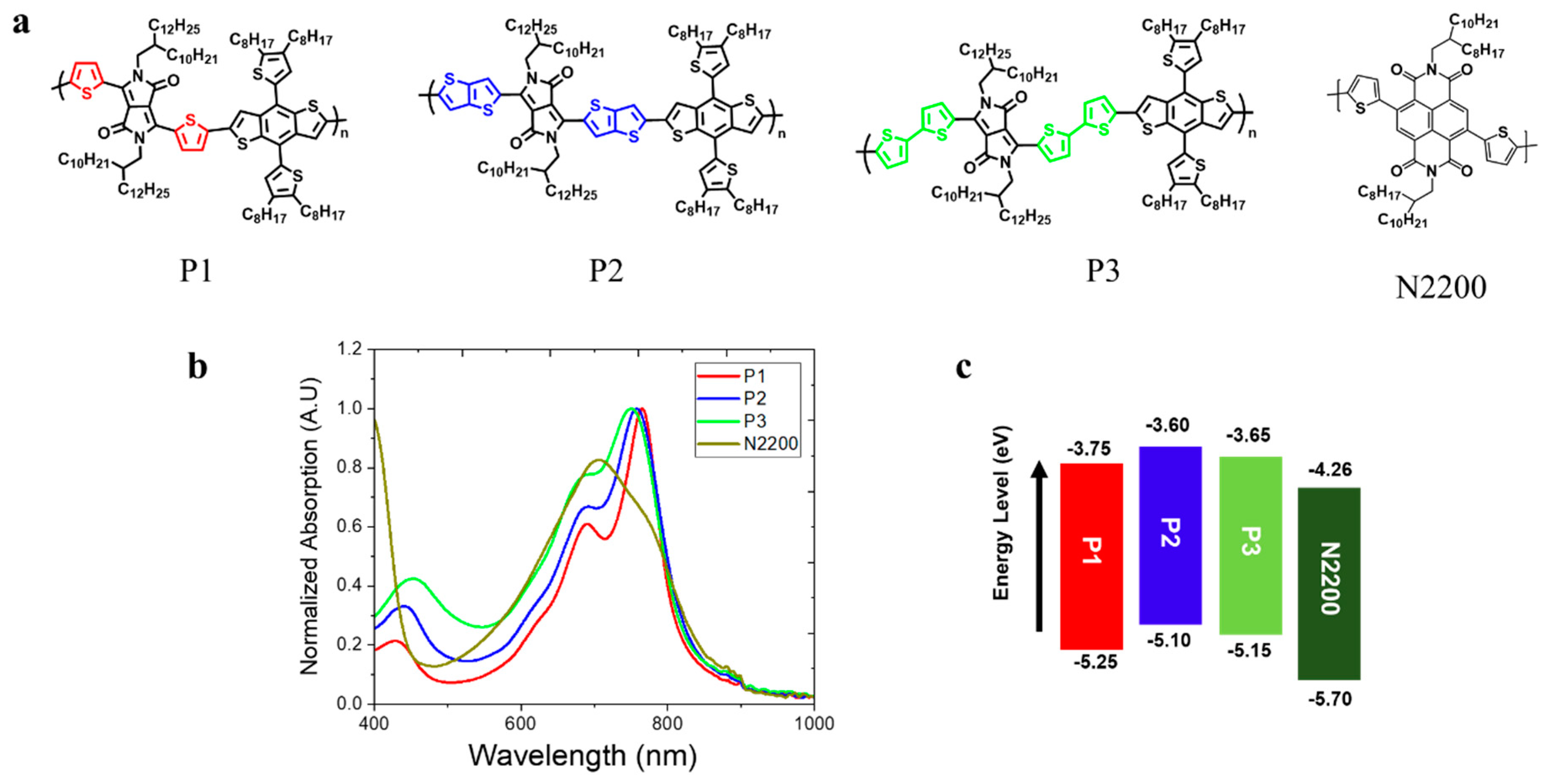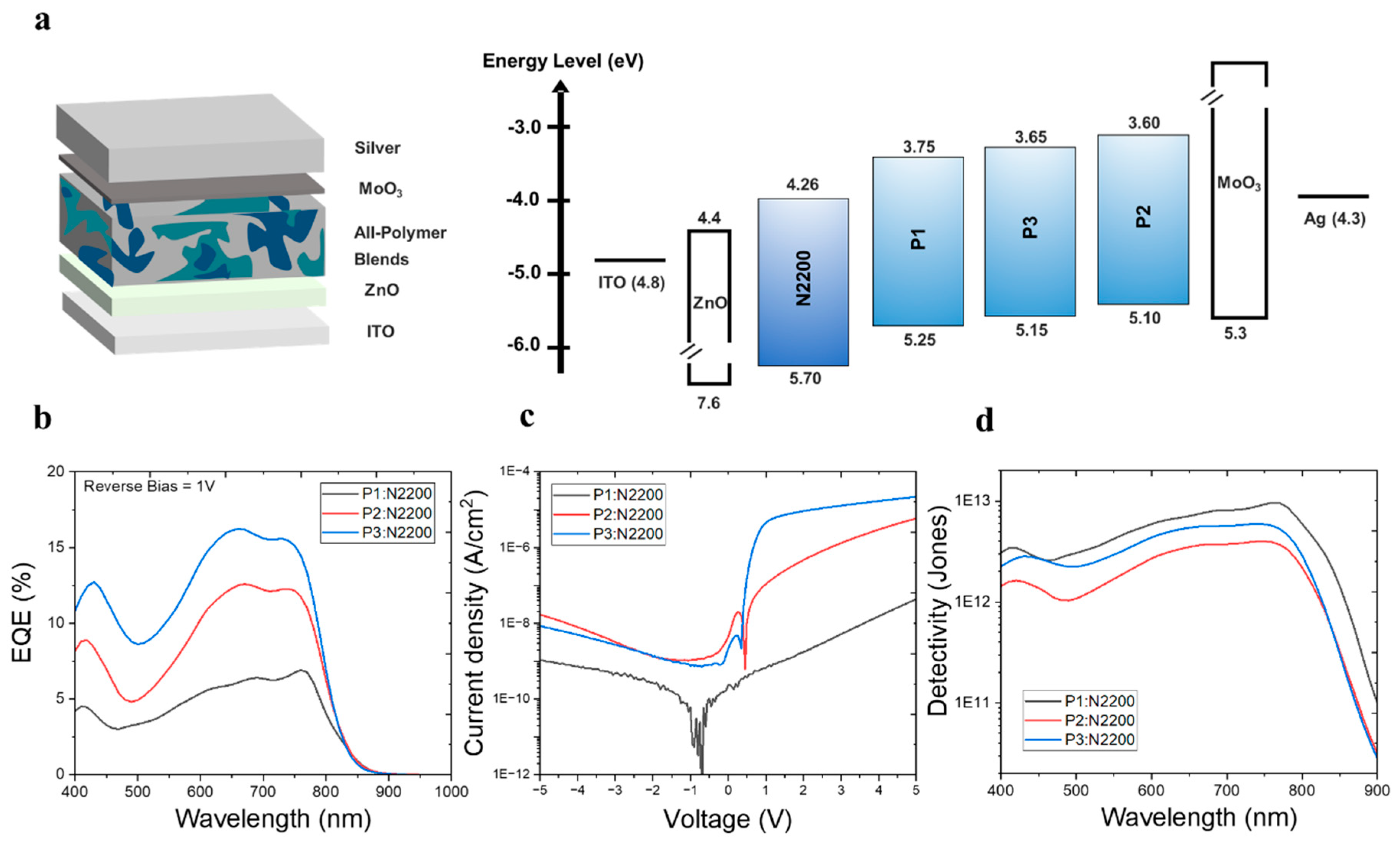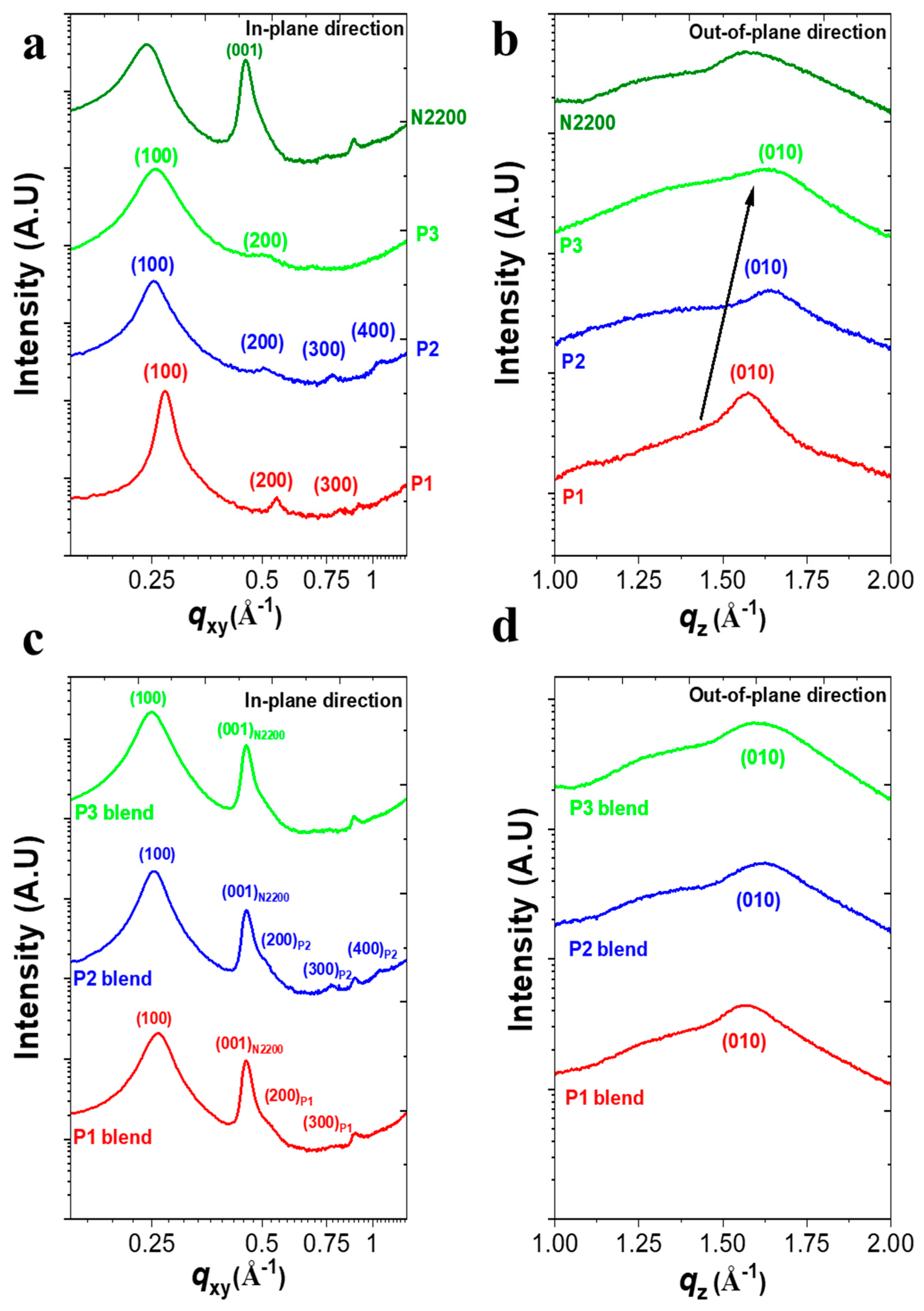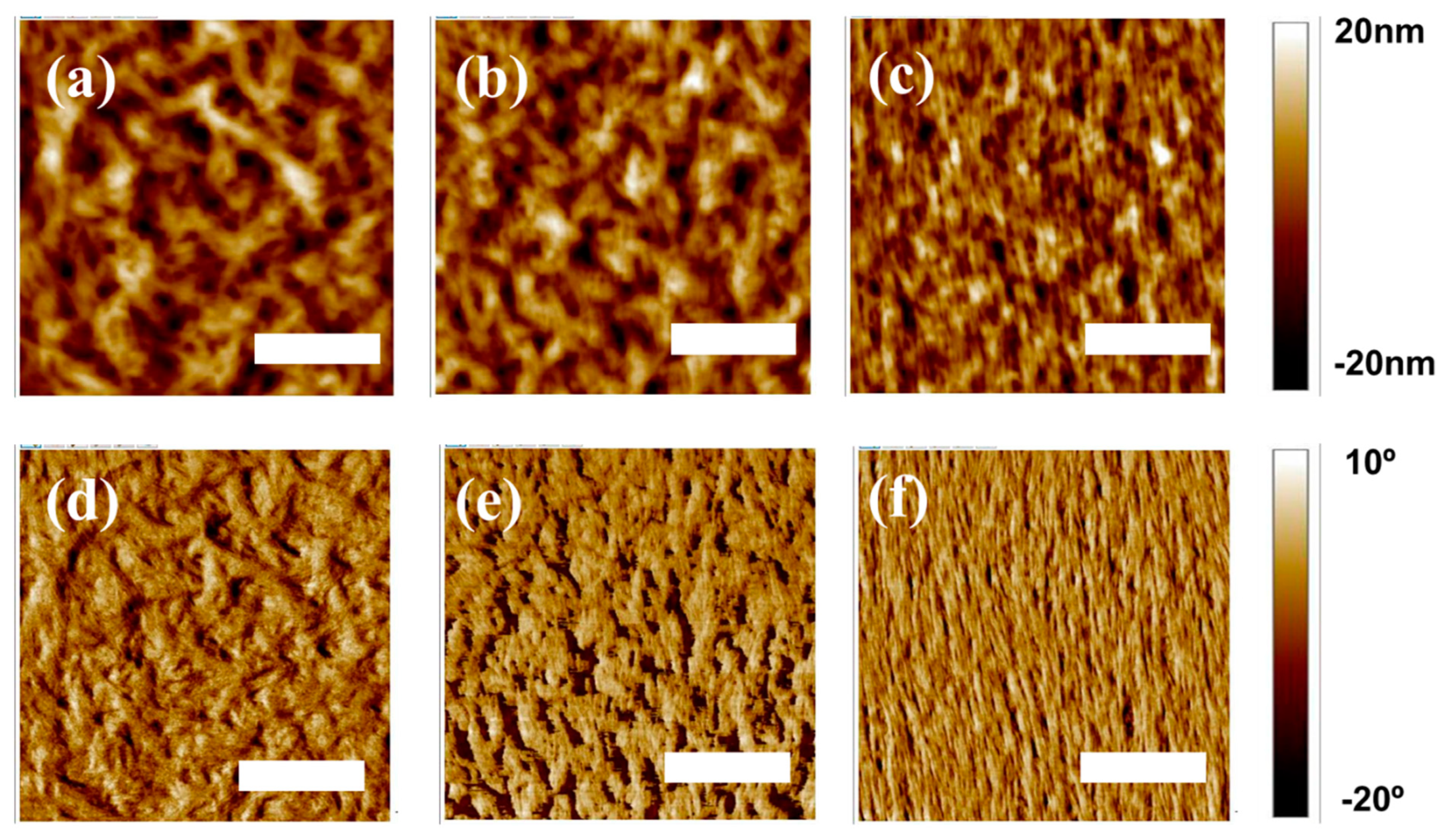Effects of Conjugation Spacers in Diketopyrrolopyrrole-Based Copolymers for All-Polymer-Based Photodiodes
Abstract
:1. Introduction
2. Materials and Methods
2.1. Materials
2.2. Synthesis
2.3. Fabrication and Characterization of All-PPDs
2.4. Other Characterizations
3. Results and Discussion
3.1. Synthesis and Characterization of PDs and PA
3.2. All-PPD Device Characterization
3.3. Morphology Characterization
4. Conclusions
Supplementary Materials
Author Contributions
Funding
Data Availability Statement
Acknowledgments
Conflicts of Interest
References
- Lee, Y.; Chung, J.W.; Lee, G.H.; Kang, H.; Kim, J.-Y.; Bae, C.; Yoo, H.; Jeong, S.; Cho, H.; Kang, S.-G.; et al. Standalone real-time health monitoring patch based on a stretchable organic optoelectronic system. Sci. Adv. 2021, 7, eabg9180. [Google Scholar] [CrossRef] [PubMed]
- Lee, G.H.; Kang, H.; Chung, J.W.; Lee, Y.; Yoo, H.; Jeong, S.; Cho, H.; Kim, J.-Y.; Kang, S.-G.; Jung, J.Y.; et al. Stretchable PPG sensor with light polarization for physical activity-permissible monitoring. Sci. Adv. 2022, 8, abm3622. [Google Scholar] [CrossRef] [PubMed]
- Fuentes-Hernandez, C.; Chou, W.-F.; Khan, T.M.; Diniz, L.; Lukens, J.; Larrain, F.A.; Rodriguez-Toro, V.A.; Kippelen, B. Large-area low-noise flexible organic photodiodes for detecting faint visible light. Science 2020, 370, 698–701. [Google Scholar] [CrossRef] [PubMed]
- Yokota, T.; Nakamura, T.; Kato, H.; Mochizuki, M.; Tada, M.; Uchida, M.; Lee, S.; Koizumi, M.; Yukita, W.; Takimoto, A.; et al. A conformable imager for biometric authentication and vital sign measurement. Nat. Electron. 2020, 3, 113–121. [Google Scholar] [CrossRef]
- Khan, Y.; Han, D.; Pierre, A.; Ting, J.; Wang, X.; Lochner, C.M.; Bovo, G.; Yaacobi-Gross, N.; Newsome, C.; Wilson, R.; et al. A flexible organic reflectance oximeter array. Proc. Natl. Acad. Sci. USA 2018, 115, E11015. [Google Scholar] [CrossRef]
- Lee, H.; Kim, E.; Lee, Y.; Kim, H.; Lee, J.; Kim, M.; Yoo, H.-J.; Yoo, S. Toward all-day wearable health monitoring: An ultralow-power, reflective organic pulse oximetry sensing patch. Sci. Adv. 2018, 4, eaas9530. [Google Scholar] [CrossRef]
- Park, Y.; Fuentes-Hernandez, C.; Kim, K.; Chou, W.-F.; Larrain, F.A.; Graham, S.; Pierron, O.N.; Kippelen, B. Skin-like low-noise elastomeric organic photodiodes. Sci. Adv. 2021, 7, eabj6565. [Google Scholar] [CrossRef]
- Park, S.; Fukuda, K.; Wang, M.; Lee, C.; Yokota, T.; Jin, H.; Jinno, H.; Kimura, H.; Zalar, P.; Matsuhisa, N.; et al. Ultraflexible near-infrared organic photodetectors for conformal photoplethysmogram sensors. Adv. Mater. 2018, 30, 1802359. [Google Scholar] [CrossRef]
- Noh, J.; Kim, G.-U.; Han, S.; Oh, S.J.; Jeon, Y.; Jeong, D.; Kim, S.W.; Kim, T.-S.; Kim, B.J.; Lee, J.-Y. Intrinsically stretchable organic solar cells with efficiencies of over 11%. ACS Energy Lett. 2021, 6, 2512–2518. [Google Scholar] [CrossRef]
- Kim, T.; Kim, J.-H.; Kang, T.E.; Lee, C.; Kang, H.; Shin, M.; Wang, C.; Ma, B.; Jeong, U.; Kim, T.-S.; et al. Flexible, highly efficient all-polymer solar cells. Nat. Commun. 2015, 6, 8547. [Google Scholar] [CrossRef]
- Choi, J.; Kim, W.; Kim, S.; Kim, T.-S.; Kim, B.J. Influence of acceptor type and polymer molecular weight on the mechanical properties of polymer solar cells. Chem. Mater. 2019, 31, 9057–9069. [Google Scholar] [CrossRef]
- Kang, H.; Lee, W.; Oh, J.; Kim, T.; Lee, C.; Kim, B.J. From fullerene–polymer to all-polymer solar cells: The importance of molecular packing, orientation, and morphology control. Acc. Chem. Res. 2016, 49, 2424–2434. [Google Scholar] [CrossRef] [PubMed]
- Kang, H.; Lee, Y.; Lee, G.H.; Chung, J.W.; Kwon, Y.-N.; Kim, J.-Y.; Kuzumoto, Y.; Gam, S.; Kang, S.-G.; Jung, J.Y.; et al. Strain-Tolerant, High-Detectivity, and Intrinsically Stretchable All-Polymer Photodiodes. Adv. Funt. Mater. 2023, 33, 2212219. [Google Scholar] [CrossRef]
- Wu, Y.; Schneider, S.; Walter, C.; Chowdhury, A.H.; Bahrami, B.; Wu, H.-C.; Qiao, Q.; Toney, M.F.; Bao, Z. Fine-Tuning Semiconducting Polymer Self-Aggregation and Crystallinity Enables Optimal Morphology and High-Performance Printed All-Polymer Solar Cells. J. Am. Chem. Soc. 2020, 142, 392–406. [Google Scholar] [CrossRef]
- Wang, X.; Gao, S.; Han, J.; Liu, Z.; Qiao, W.; Wang, Z.Y. High-Performance All-Polymer Photodetectors Enabled by New Random Terpolymer Acceptor with Fine-Tuned Molecular Weight. ACS Appl. Mater. Interfaces 2022, 14, 26978–26987. [Google Scholar] [CrossRef]
- Zhong, Z.; Li, K.; Zhang, J.; Ying, L.; Xie, R.; Yu, G.; Huang, F.; Cao, Y. High-Performance All-Polymer Photodetectors via a Thick Photoactive Layer Strategy. ACS Appl. Mater. Interfaces 2019, 11, 14208–14214. [Google Scholar] [CrossRef]
- Zhou, X.; Yang, D.; Ma, D. Extremely Low Dark Current, High Responsivity, All-Polymer Photodetectors with Spectral Response from 300 nm to 1000 nm. Adv. Opt. Mater. 2015, 3, 1570–1576. [Google Scholar] [CrossRef]
- Li, W.; Hendriks, K.H.; Wienk, M.M.; Janssen, R.A.J. Diketopyrrolopyrrole Polymers for Organic Solar Cells. Acc. Chem. Res. 2016, 49, 78–85. [Google Scholar] [CrossRef]
- Cheon, H.-J.; An, T.K.; Kim, Y.-H. Diketopyrrolopyrrole (DPP)-Based Polymers and Their Organic Field-Effect Transistor Applications: A Review. Macromol. Res. 2022, 30, 71–84. [Google Scholar] [CrossRef]
- Mun, J.; Ochiai, Y.; Wang, W.; Zheng, Y.; Zhen, Y.-Q.; Wu, H.-C.; Matsuhisa, N.; Higashihara, T.; Tok, J.B.-H.; Yun, Y.; et al. A design strategy for high mobility stretchable polymer semiconductors. Nat. Commun. 2021, 12, 3572. [Google Scholar] [CrossRef]
- Pace, G.; Bargigia, I.; Noh, Y.-Y.; Silva, C.; Caironi, M. Intrinsically distinct hole and electron transport in conjugated polymers controlled by intra and intermolecular interactions. Nat. Commun. 2019, 10, 5226. [Google Scholar] [CrossRef] [PubMed]
- Seo, S.; Kim, J.; Kang, H.; Lee, J.-W.; Lee, S.; Kim, G.-U.; Kim, B.J. Polymer Donors with Temperature-Insensitive, Strong Aggregation Properties Enabling Additive-Free, Processing Temperature-Tolerant High-Performance All-Polymer Solar Cells. Macromolecules 2021, 54, 53–63. [Google Scholar] [CrossRef]
- Li, Y.; Chang, C.-Y.; Chen, Y.; Song, Y.; Li, C.-Z.; Yip, H.-L.; Jen, A.K.-Y.; Li, C. The effect of thieno [3,2-b]thiophene on the absorption, charge mobility and photovoltaic performance of diketopyrrolopyrrole-based low bandgap conjugated polymers. J. Mater. Chem. C 2013, 1, 7526–7533. [Google Scholar] [CrossRef]
- Simone, G.; Dyson, M.J.; Weijtens, C.H.L.; Meskers, S.C.J.; Coehoorn, R.; Janssen, R.A.J.; Gelinck, G.H. On the Origin of Dark Current in Organic Photodiodes. Adv. Opt. Mater. 2020, 8, 1901568. [Google Scholar] [CrossRef]
- Liu, C.; Dong, S.; Cai, P.; Liu, P.; Liu, S.; Chen, J.; Liu, F.; Ying, L.; Russell, T.P.; Huang, F.; et al. Donor–Acceptor Copolymers Based on Thermally Cleavable Indigo, Isoindigo, and DPP Units: Synthesis, Field Effect Transistors, and Polymer Solar Cells. ACS Appl. Mater. Interfaces 2015, 7, 9038–9051. [Google Scholar] [CrossRef]
- Kielar, M.; Dhez, O.; Pecastaings, G.; Curutchet, A.; Hirsch, L. Long-term stable organic photodetectors with ultra low dark currents for high detectivity applications. Sci. Rep. 2016, 6, 39201. [Google Scholar] [CrossRef]
- Huang, J.; Lee, J.; Vollbrecht, J.; Brus, V.V.; Dixon, A.L.; Cao, D.X.; Zhu, Z.; Du, Z.; Wang, H.; Cho, K.; et al. A high-performance solution-processed organic photodetector for near-infrared sensing. Adv. Mater. 2020, 32, 1906027. [Google Scholar] [CrossRef]
- Peng, Z.; Ye, L.; Ade, H. Understanding, quantifying, and controlling the molecular ordering of semiconducting polymers: From novices to experts and amorphous to perfect crystals. Mater. Horiz. 2022, 9, 577–606. [Google Scholar] [CrossRef]
- Lee, C.; Lee, S.; Kim, G.-U.; Lee, W.; Kim, B.J. Recent Advances, Design Guidelines, and Prospects of All-Polymer Solar Cells. Chem. Rev. 2019, 119, 8028–8086. [Google Scholar] [CrossRef]
- Schubert, M.; Collins, B.A.; Mangold, H.; Howard, I.A.; Schindler, W.; Vandewal, K.; Roland, S.; Behrends, J.; Kraffert, F.; Steyrleuthner, R.; et al. Correlated Donor/Acceptor Crystal Orientation Controls Photocurrent Generation in All-Polymer Solar Cells. Adv. Funct. Mater. 2014, 24, 4068–4081. [Google Scholar] [CrossRef]
- Kang, H.; Uddin, M.A.; Lee, C.; Kim, K.-H.; Nguyen, T.L.; Lee, W.; Li, Y.; Wang, C.; Woo, H.W.; Kim, B.J. Determining the Role of Polymer Molecular Weight for High-Performance All-Polymer Solar Cells: Its Effect on Polymer Aggregation and Phase Separation. J. Am. Chem. Soc. 2015, 137, 2359–2365. [Google Scholar] [CrossRef]
- Collins, B.A.; Li, Z.; Tumbleston, J.R.; Gann, E.; McNeill, C.R.; Ade, H. Absolute Measurement of Domain Composition and Nanoscale Size Distribution Explains Performance in PTB7:PC71BM Solar Cells. Adv. Energy Mater. 2013, 3, 65–74. [Google Scholar] [CrossRef]
- Zhong, Z.; Bu, L.; Zhu, P.; Xiao, T.; Fan, B.; Yin, L.; Lu, G.; Yu, G.; Huang, F.; Cao, Y. Dark Current Reduction Strategy via a Layer-By-Layer Solution Process for a High-Performance All-Polymer Photodetector. ACS Appl. Mater. Interfaces 2019, 11, 8350–8356. [Google Scholar] [CrossRef]
- Qi, J.; Qiao, W.; Zhou, X.; Yang, D.; Zhang, J.; Ma, D.; Wang, Z.Y. High-Detectivity All-Polymer Photodetectors with Spectral Response from 300 to 1100 nm. Macromol. Chem. Phys. 2016, 217, 1683–1689. [Google Scholar] [CrossRef]
- Hu, L.; Qiao, W.; Han, J.; Zhou, X.; Wang, C.; Ma, D.; Wang, Z.Y.; Li, Y. Naphthalene diimide–diketopyrrolopyrrole copolymers as non-fullerene acceptors for use in bulk-heterojunction all-polymer UV–NIR photodetectors. Polym. Chem. 2017, 8, 528–536. [Google Scholar] [CrossRef]
- Zhao, Y.; Liu, T.; Wu, B.; Zhang, S.; Prine, N.; Zhang, L.; Pang, S.; Yin, B.; Ye, L.; Gu, X.; et al. High-Performance All-Polymer Solar Cells and Photodetectors Enabled by a High-Mobility n-Type Polymer and Optimized Bulk-Heterojunction Morphology. Chem. Mater. 2021, 33, 3746–3756. [Google Scholar] [CrossRef]
- Murto, P.; Genene, Z.; Benavides, C.M.; Xu, X.; Sharma, A.; Pan, X.; Schmidt, O.; Brabec, C.J.; Andersson, M.R.; Tedde, S.F.; et al. High Performance All-Polymer Photodetector Comprising a Donor–Acceptor–Acceptor Structured Indacenodithiophene–Bithieno [3,4-c]Pyrroletetrone Copolymer. ACS Macro Lett. 2018, 7, 395–400. [Google Scholar] [CrossRef]
- Kim, H.; Kang, J.; Park, J.; Ahn, H.; Kang, I.-N.; Jung, I.H. All-Polymer Photodetectors with n-Type Polymers Having Nonconjugated Spacers for Dark Current Density Reduction. Macromolecules 2022, 55, 9489–9501. [Google Scholar] [CrossRef]




| Polymer | Mn (a) [kg mol−1] | Mw (a) [kg mol−1] | Ð (a) [Mw/Mn] | Film λmax [nm] | Egopt (b) [eV] | EHOMO(c) [eV] | ELUMO(d) [eV] |
|---|---|---|---|---|---|---|---|
| P1 | 60.1 | 137.4 | 2.29 | 765 | 1.50 | −5.25 | −3.75 |
| P2 | 37.8 | 95.9 | 2.54 | 758 | 1.50 | −5.10 | −3.60 |
| P3 | 42.2 | 89.4 | 2.12 | 750 | 1.50 | −5.15 | −3.65 |
| N2200 | - | - | 1.44 | −5.70 | −4.26 |
| Polymer | In-Plane Direction | Out-of-Plane Direction | ||
|---|---|---|---|---|
| d100 [Å] | Lc(100) [Å] | d010 [Å] | Lc(010) [Å] | |
| P1 | 23.09 | 206.68 | 3.99 | 46.04 |
| P2 | 24.69 | 107.12 | 3.79 | 38.76 |
| P3 | 24.38 | 82.99 | 3.80 | 31.84 |
Disclaimer/Publisher’s Note: The statements, opinions and data contained in all publications are solely those of the individual author(s) and contributor(s) and not of MDPI and/or the editor(s). MDPI and/or the editor(s) disclaim responsibility for any injury to people or property resulting from any ideas, methods, instructions or products referred to in the content. |
© 2023 by the authors. Licensee MDPI, Basel, Switzerland. This article is an open access article distributed under the terms and conditions of the Creative Commons Attribution (CC BY) license (https://creativecommons.org/licenses/by/4.0/).
Share and Cite
Kang, H.; Kim, H.; Choi, A.; Yun, Y.; Lee, G.H. Effects of Conjugation Spacers in Diketopyrrolopyrrole-Based Copolymers for All-Polymer-Based Photodiodes. Crystals 2023, 13, 1454. https://doi.org/10.3390/cryst13101454
Kang H, Kim H, Choi A, Yun Y, Lee GH. Effects of Conjugation Spacers in Diketopyrrolopyrrole-Based Copolymers for All-Polymer-Based Photodiodes. Crystals. 2023; 13(10):1454. https://doi.org/10.3390/cryst13101454
Chicago/Turabian StyleKang, Hyunbum, Hyungjun Kim, Ajeong Choi, Youngjun Yun, and Gae Hwang Lee. 2023. "Effects of Conjugation Spacers in Diketopyrrolopyrrole-Based Copolymers for All-Polymer-Based Photodiodes" Crystals 13, no. 10: 1454. https://doi.org/10.3390/cryst13101454





